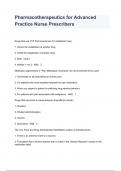Exam (elaborations)
Pharmacotherapeutics for Advanced Practice Nurse Prescribers
- Course
- Institution
Pharmacotherapeutics for Advanced Practice Nurse Prescribers Drugs that use CYP 3A4 isoenzymes for metabolism may: 1. Induce the metabolism of another drug 2. Inhibit the metabolism of another drug 3. Both 1 and 2 4. Neither 1 nor 2 - ANS 3 Medication agreements or "Pa...
[Show more]



